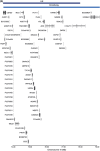Regions of homozygosity as risk factors for multiple myeloma
- PMID: 30768683
- PMCID: PMC6563058
- DOI: 10.1111/ahg.12304
Regions of homozygosity as risk factors for multiple myeloma
Abstract
Genomic regions of homozygosity (ROH), detectable in outbred populations, have been implicated as determinants of inherited risk. To examine whether ROH is associated with risk of multiple myeloma (MM), we performed whole-genome homozygosity analysis using single-nucleotide polymorphism genotype data from 2,282 MM cases and 5,197 controls, with replication in an additional 878 MM cases and 7,083 controls. Globally, the distribution of ROH between cases and controls was not significantly different. However, one ROH at chromosome 9q21, harboring the B-cell transcription factor gene KLF9, showed evidence of a consistent association and may therefore warrant further investigation as a candidate risk factor for MM. Overall, our analysis provides little support for a homozygosity signature being a significant factor in MM risk.
Keywords: genetics; multiple myeloma; risk factor.
© 2019 The Authors. Annals of Human Genetics published by University College London (UCL) and John Wiley & Sons Ltd.
Conflict of interest statement
The authors declare no conflict of interest.
Figures



References
-
- Altieri, A. , Chen, B. , Bermejo, J. L. , Castro, F. , & Hemminki, K. (2006). Familial risks and temporal incidence trends of multiple myeloma. European Journal of Cancer, 42, 1661–1670. - PubMed
-
- Assie, G. , Laframboise, T. , Platzer, P. , & Eng, C. (2008). Frequency of germline genomic homozygosity associated with cancer cases. JAMA, 299, 1437–1445. - PubMed
Publication types
MeSH terms
Grants and funding
LinkOut - more resources
Full Text Sources
Medical

